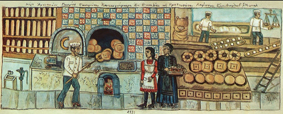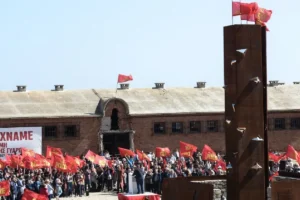About 150 years ago, the influential folk artist Theophilus (Theophilus Kefalas – Hatzimichail) was born in the village of Vareia, on the south-eastern tip of the island of Lesvos, overlooking the shores of Asia Minor.
While the year of his birth is still in dispute, and is generally thought to be between 1868 and 1871, however one thing is certain, Theophilus was born and raised in a society deeply influenced by superstition.

As a left-hander he was shunned by his contemporaries due to a common belief that the devil himself was left-handed.
As a result, Theophilus’ teachers forced him, often through violence, to write with his right hand, the ‘correct hand’. Additionally,
Theophilus was mocked because, as Greece was slowly looking towards Western Europe in regards to clothing trends and fashion, he remained faithful to the traditional Greek garment known as “foustanela”.
From an early age, Theophilus, the oldest of eight siblings, displayed a remarkable talent for painting. Having learnt the basics from his maternal grandfather, a byzantine iconographer, he left his hometown at the age of 18.
After working briefly as a concierge at the Hellenic Consulate in Smyrna, he moved to the coastal port city of Volos in Thessaly (around 1897) to find work as a painter.
Under the patronage of Giannis Kontos, a wealthy landowner, Theophilus spent many years in the village of Pilio where he painted extensively, often painting murals and frescoes inside businesses and cafes in the region.

During this time, he organised numerous theatre productions for the Greek Carnival known as “Apokria”, with the cast wearing original costumes that he had designed.
In 1927 he left Volos to live in Mytilene. His departure from Volos is often attributed to an episode in a cafe, when someone – to entertain the attendants – threw him from the ladder he had been standing on while working.
In Mytilene he returned to painting, making several frescoes in surrounding villages.
Despite his talent he could summon only the feeblest payments from his clients, usually just a plate of food and some wine.
His works drew inspiration from Byzantium, ancient Greek mythology, Greek history, every day village life, portraits and landscapes.
Erotokritos, the great epic poem of the 17th-century Cretan Renaissance was a special favourite of his. Many of his works of this period have been lost either as a result of natural deterioration, or due to the destruction by their owners.
Theophilus ’ unique style and genius remained unrecognised until the influential Greek art critic and publisher from Paris, Stratis Eleftheriadis (also known as Tériade) came across his oeuvre in the 1920s. Sadly,
Theophilus passed away in 1934, two years before an exhibition of his work in Paris.
A similar exhibition of his work wouldn’t take place in Greece until 1947, thirteen years after his death.

In 1961 the Musée des Arts Décoratifs in Paris exhibited 44 paintings from Tériade’s collection. In 1965 the Theophilus Museum, financed by Tériade opened its doors and housed his entire collection of works by the artist.
Perhaps Theophilos himself should have the last word, in the wonderful story recounted by the Nobel prize laureate poet Giorgos Seferis:
Once upon a time, as they say, a baker commissioned a poor painter to paint a picture of him taking loaves of bread out of the oven.
The painter started on his work, and when he came to putting in the baker’s rake, instead of following the laws of perspective and making it horizontal, he drew it perpendicular, showing the whole breadth of its surface; then, in the same way, he drew a loaf of bread on the rake.

A clever man came past and said to the painter, “That loaf of bread is going to fall down, the way you’ve painted it.”
Without bothering to turn his head, the painter replied, “Don’t worry. Only real loaves fall down; the painted ones stay put”.













